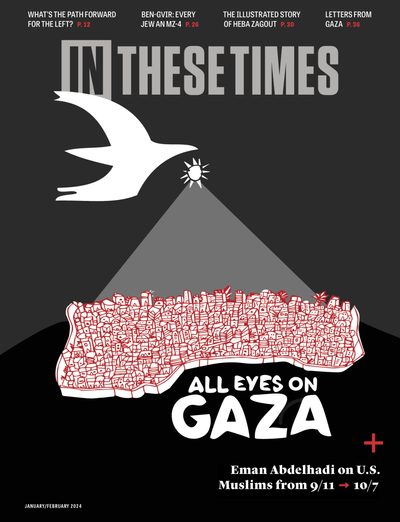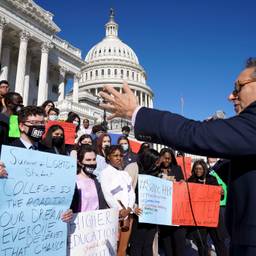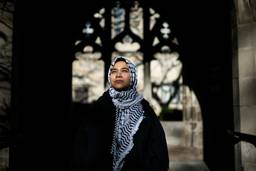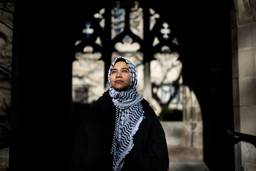Every Jew a .22 and MZ-4: The Path from Kahane to Ben-Gvir
The rise of far-right extremism in Israel is a long time coming, and it has deep roots in settler violence against Palestinians.
Natasha Roth-Rowland

Itamar Ben-Gvir, Israel’s national security minister and head of the extremist Otzma Yehudit (Jewish Power) party, traveled up and down Israel distributing assault rifles (including MZ-4s) to Jewish-Israeli citizens in the weeks following Hamas’ attack on southern Israel on October 7. It was a significant escalation in Ben-Gvir’s ongoing efforts to arm Jewish Israelis and, using these events as photo ops, the far-right lawmaker was greeted with great fanfare by the recipients — new civilian guards, intended to become “rapid response” groups.
These civilian-arming events irked the U.S. government— which has been providing additional arms to the Israeli military since the outbreak of the war — and led to a threat from the Biden administration that the United States would stop sending guns.
It was a rare moment of discord between the two governments since the most recent violence began. The United States has supported Israel lock, stock and barrel in its relentless bombardment of the Gaza Strip in retaliation for Hamas’ attacks.
But given Ben-Gvir’s politics — and his personal history — it is unsurprising he was the one to cause the upset.
Ben-Gvir and his party are the ideological and institutional descendants of the late Rabbi Meir Kahane, an American-born Jewish extremist who began his career in New York in the 1960s. The following decade, Kahane moved to Israel and founded the fascist Kach party. The name translates to “thus,” a nod to “rak kach” or “only thus,” the slogan of the Jewish far-right militia group the Irgun. In the 1940s, operating in Mandatory Palestine, the group was responsible for the King David Hotel bombing in Jerusalem and was involved in the Deir Yassin massacre.
Ben-Gvir’s extremism — and that of Jewish Power — is well-recognized in Israeli society and internationally. Ben-Gvir has been convicted of supporting a terrorist organization (Kach) and of incitement to racism, and he has been caught on camera at least twice pulling a gun on Palestinians. Other members of his party have, even recently, threatened to “blow up” a Jewish-Palestinian children’s summer camp, praised as a “holy, righteous man” a convicted Jewish terrorist who murdered three Palestinians, and suggested Israel could drop a nuclear bomb on Gaza.
The Israeli government, labeling Kach as a terrorist movement, outlawed the party in 1994, following a massacre carried out by one of its adherents; it had already been banned from parliamentary politics in 1988. In 1997, the United States designated Kach and its off-shoots as foreign terrorist organizations, although the State Department revoked this designation in 2022.
Kach and its descendants were, electorally speaking, pariahs for most of the following decades. So a critical question in understanding current Israeli politics is this: How did a political party directly linked to that terrorist movement end up with an unprecedented level of power and influence in the Israeli government? And how did Ben-Gvir end up playing kingmaker in the wake of Israel’s most recent national elections and subsequently get appointed to oversee the country’s police?
Kahane’s movement, which has long maintained its ideological-activist core, trod a winding path into power — moving between New York, Jerusalem and the occupied West Bank — and pockmarked by bombings, a massacre and an assassination.
A major part of the backstory of Itamar Ben-Gvir’s present-day politics begins in civil-rights-era Brooklyn, where Meir Kahane, along with a couple of fellow ideologues, formed the Jewish Defense League (JDL), a racist vigilante group that preached Jewish pride, Jewish violence and Jewish supremacism.
The JDL patrolled New York City neighborhoods prone to racial tension, brandishing weapons, threatening violence and (in the words of its critics) acting like a “goon squad.” This quickly escalated into terrorist attacks against Soviet and Arab targets, including the JDL’s bombing of the Soviet mission to the United Nations and the Palestine Liberation Organization offices in New York.
Fleeing a series of criminal charges over the JDL’s violent activities, including for possession of weapons, Kahane arrived in Israel in the early 1970s and rapidly set about internationalizing his American movement. He quickly won followers in the process.
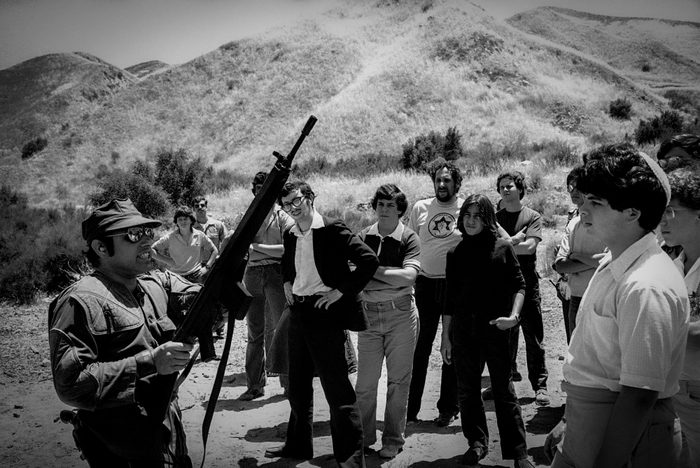
As with the JDL, Kahane used his Kach movement to nurture a politics of grievance, coupling virulent anti-Arab racism, messianic Jewish supremacism and general chauvinism with the resentment of those Israelis whom the mainstream establishment had long excluded and discriminated against — often, Jewish people of Middle Eastern and North African origin and, later, those recently arrived from the Soviet Union. These communities were consistently pushed to the social, political and economic margins by an Ashkenazi (European) hegemony, which has dominated Israeli politics and institutions since the founding of the state.
Kach, with its openly fascist platform, sought to criminalize relationships between Jews and Palestinians, segregate the two communities wherever possible, and ultimately expel Palestinians. A proposed law put forward by Kahane in late 1984, for example, specified separate beaches for Jews and non-Jews and imprisonment for anyone engaging in a mixed Jewish/non-Jewish romantic relationship.
Kach had limited parliamentary success during its time as an active movement. It won a solitary seat in the Knesset (Israeli parliament) in the 1984 Israeli elections at the fourth attempt, with Kahane serving as that sole representative. By 1988, with polls suggesting Kach was on track to win as many as six seats in the upcoming elections, the Israeli government banned Kach from running.
Outwardly, this was done on the basis of Kach’s racist and undemocratic platform; in reality, however, the push to bar Kach had been driven by other right-wing parties that feared Kahane’s movement would undermine their own share of seats in the Knesset. Among them was Likud — the current ruling party that has dominated Israeli politics since the late 1970s.
The Kach movement then suffered two critical blows. Kahane was assassinated in New York City in 1990 by an Egyptian-born American citizen, and his party was banned outright in 1994 after Baruch Goldstein, another Brooklyn-born extremist (and Kahane’s former campaign manager) murdered 29 Palestinians during prayer in the occupied West Bank city of Hebron. (Until early 2020, Ben-Gvir had a photo of Goldstein, whom he considered a “hero,” on his living room wall; he took it down under pressure from potential election partners.)
Both the Israeli and U.S. governments designated Kach, and its offshoot Kahane Chai (“Kahane Lives”), as terrorist organizations. But the movement’s inroads into Israeli society, facilitated by the country’s mainstream politics of ethnic exclusion and territorial expansion — summarized in the longstanding Zionist imperative of “maximum land, minimum Arabs” — would not be undone by the legal banning of its flagship organization.
“Kahanism” became a recognized and entrenched political worldview and methodology. Its adherents, though seemingly down and out in the mid-1990s, would have their moment in the sun once again.
It might seem implausible that Otzma Yehudit, a Kahanist party, won multiple seats in the Israeli parliament more than 30 years after its predecessor had been banned from running — and almost three decades after the extremist party had been altogether outlawed. But this reversal reveals how extremist ideas can make their way into the mainstream, and how simply banning fascist groups is not enough to contain the spread of their ideas.
There are two key pieces to this puzzle. The first — which is complex, and has been developing for decades — is the wider rightward shift of Israeli politics and society. Multiple factors have contributed to this trend, including the entrenched violence of decades of occupation and the expansion of the Israeli settlement project; the Jewish supremacism baked into Israel’s institutions; the violence and destabilization of the first and particularly the second intifadas; the repeated failed peace processes; and Israel’s unrelenting militarism. All of these elements created fertile soil for sustaining and growing Kahanist politics that promised total victory — understood as the complete subjugation, if not expulsion, of all non-Jews in the country — that would be achieved through righteous Jewish violence.
Yet Kahanism’s triumphant return to the Knesset did not happen entirely organically. The second piece of the puzzle is Prime Minister Benjamin Netanyahu, a far-right populist with an authoritarian bent who has led the country for most of the past 15 years as the head of Likud. Dogged by personal and political corruption indictments, trials, exposés and long-running protests against his rule, Netanyahu has so far escaped serious punishment — but the numerous controversies have weighed him down and contributed to significant political instability, leading to a whirlwind of repeat elections in the late 2010s and early 2020s in which he played a pivotal role in guiding Otzma Yehudit into government. Recognizing his electoral precarity and determined to maintain power, Netanyahu repeatedly orchestrated efforts to try to ensure the Kahanist party, led by Ben-Gvir, would secure enough votes to make it into the Israeli parliament, thereby bolstering a far-right coalition.
In 2021, these efforts were partly successful. Ben-Gvir made it into the Knesset as part of a Netanyahu-brokered electoral merger with the Religious Zionist Party, which was led by now-Finance Minister and far-right ideologue Bezalel Smotrich. (Smotrich is himself one of the most extreme figures in Israeli politics, who was suspected of involvement in a terror plot in the 2000s, has labeled himself a “proud homophobe” and said that a West Bank Palestinian town that had just been subjected to a settler pogrom needed to be “wiped out.”)
Ben-Gvir was confined to the opposition — Netanyahu had failed to secure a right-wing coalition, forcing him to vacate the prime minister’s office for the first time in 12 years. But with a new level of media exposure, Ben-Gvir rapidly became one of Israel’s political stars.
The May 2021 Unity Intifada — sparked when tensions over the forced displacement of Palestinians in East Jerusalem rapidly escalated into another Israel-Gaza war, and which also brought with it severe intercommunal violence in mixed Jewish-Palestinian cities — sent Ben-Gvir’s profile soaring, helped along by his deliberately provocative political stunts like opening a parliamentary “office” in the East Jerusalem neighborhood undergoing settler-driven expulsion efforts and, even more so, his open invitation onto Israeli news shows. Where Kahane had been subject to a de facto media blackout upon entering the Knesset, Ben-Gvir was second only to then-Prime Minister Naftali Bennett as the most frequent political guest on Israeli television and radio during a spike in violence in March 2022 — with the press helping to mainstream Ben-Gvir and his ideas in much the same way the U.S. media did with Donald Trump during his 2016 presidential campaign.
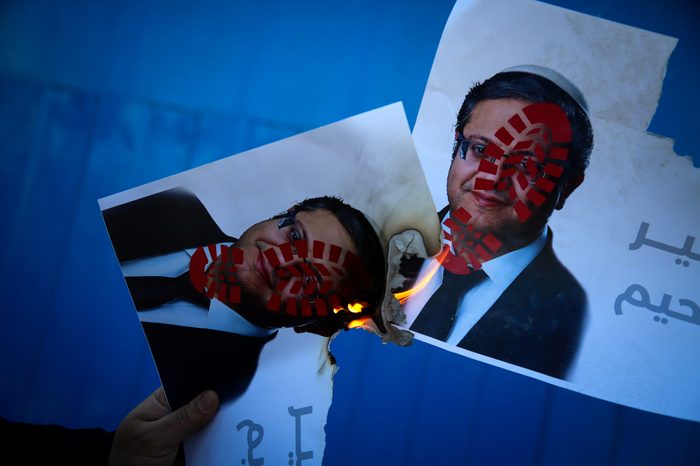
This trend continued through the unrest that followed in 2021, cementing Ben-Gvir’s status as a bona fide political force. By the time Israeli elections were held in November 2022, that momentum had translated into an established political base. The same combined slate Ben-Gvir ran on in March 2021 — the Religious Zionist Party, Otzma Yehudit and Noam (a largely single-issue homophobic one-man band) — had more than doubled its vote haul, catapulting from six seats to 14. This made it the third-largest slate in the Knesset (although the parties split once again after the government was sworn in).
With this level of bargaining power, Ben-Gvir was able to ask for — and get — the newly expanded National Security Ministry, which oversees Israel’s combined police forces, both within Israel “proper” and within the occupied territories. Ben-Gvir has also been campaigning to establish a “national guard”—essentially a private militia — which, although not yet up and running, is increasingly closer after Ben-Gvir’s October push to further loosen firearms regulations and distribute thousands of guns up and down the country. (This project also has American connections: Jewish gun ownership was a consistent JDL campaign, promoted under the slogan “Every Jew a .22”; more recently, U.S. conservatives have helped export the country’s gun culture wars to Israel.)
Ben-Gvir is now positioned as one of Israel’s most significant ministers at a time of huge peril in Israel and Palestine and, by consequence, the wider region. But, as much as Ben-Gvir is the most visible and blatant example of the eliminationist current running through Israeli society and politics, his supposedly more mainstream peers are not far behind. The attitude is made clear by their statements in the wake of the Hamas massacres: Netanyahu told the Israeli parliament that the war against Hamas was “a struggle between the children of light and the children of darkness, between humanity and the law of the jungle.” Defense Minister Yoav Gallant, ordering a “complete siege” on Gaza, said Israel was “fighting human animals.” Former Prime Minister Naftali Bennett, asked by a journalist about the risk to Gazan Palestinians in hospitals on life support and babies in incubators after Israel cut power to the Strip, angrily retorted: “Are you seriously … asking me about Palestinian civilians? What’s wrong with you?” There is also frequent discussion by Israeli officials about battling Nazis and an often-heard belief — if sometimes half-heartedly denied — that there are no innocent civilians in Gaza.
This tells us, perhaps, the key thing we need to understand about Ben-Gvir. Yes, he is a textbook extremist and a gleeful provocateur, whose rise to prominence warrants attention and study. But he is, above all, an elected politician, serving in a government of peers.
Natasha Roth-Rowland is a writer and researcher at Diaspora Alliance, and a former editor at +972 Magazine. She holds a doctorate in History from the University of Virginia. She spent several years in Israel-Palestine and is now based in New York.
